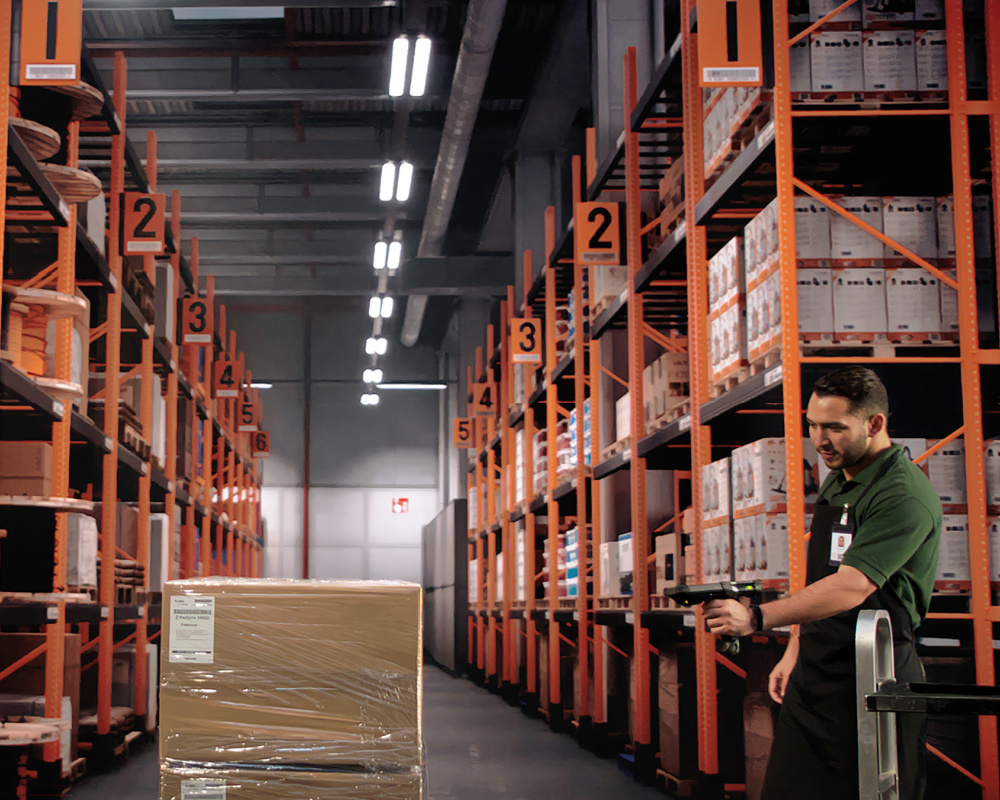
Navigating Operational Excellence: A Guide to Efficient Warehouse Management
Efficient warehouse management is the heartbeat of a successful supply chain. In the fast-paced realm of logistics, businesses continually strive to enhance their operations to meet increasing customer demands. By implementing strategic methods and harnessing the power of technology, warehouses can achieve optimal efficiency, streamline processes, and ensure customer satisfaction. In this blog, we delve into the five best ways to improve warehouse management, offering practical insights to elevate your warehouse operations to the next level.
In this article:
-
Embrace Technology and Automation
-
Efficient Space Utilization
-
Prioritize Training and Workforce Management
-
Implement Demand Forecasting
-
Continuous Process Improvement
Key Takeaways:
-
Integrating technology, such as a Warehouse Management System (WMS) and automation tools, can significantly enhance warehouse efficiency. Automation reduces manual labor and errors, while real-time data analytics empowers informed decision-making.
-
Efficient use of warehouse space is vital for reducing operational costs and maximizing storage capacity. Optimizing layout, employing vertical storage solutions, and employing smart slotting techniques can minimize travel distances and improve overall productivity.
-
Constantly improving processes, through lean principles and the feedback of your workforce, is crucial for a successful warehouse management strategy. Additionally, accurate demand forecasting based on KPIs, historical data, and predictive analytics can help businesses proactively adjust inventory levels, reducing costs and enhancing customer satisfaction.
1. Embrace Technology and Automation
The integration of technology is a transformative force in modern warehouse management. Utilizing a robust Warehouse Management System (WMS) is at the core of this transformation. A WMS empowers you to streamline tasks, from inventory tracking and order processing to workforce management. Incorporating automation technologies, such as robotics for picking and packing, can significantly reduce manual labor and the risk of errors. The implementation of barcode scanners, Radio Frequency Identification (RFID) tags, and real-time data analytics allows for precise inventory monitoring and quick, informed decision-making.
Examples of Modern Technologies:
-
-
Warehouse Management System (WMS): Implementing a WMS allows for real-time tracking of inventory, orders, and shipments. It streamlines processes like order picking and replenishment, ensuring accurate and timely product movement. For instance, an online retailer can use a WMS to efficiently manage the influx of orders during peak seasons, automating order processing and reducing the risk of errors.
-
Barcode Scanning and RFID Technology: Barcode scanners and RFID tags enable quick and accurate tracking of inventory. When items are received, picked, or shipped, scanning or RFID technology updates the inventory database in real-time. An electronics distributor can use RFID to rapidly identify and track individual components, improving accuracy and reducing manual data entry.
-
Autonomous Mobile Robots (AMRs): AMRs are robotic vehicles that can autonomously move goods within a warehouse. They can transport goods from one area to another, assist in picking and replenishment, and optimize the movement of materials. An example is an automotive parts manufacturer using AMRs to transport components from storage to assembly lines, minimizing manual labor and increasing efficiency.
-
Predictive Analytics for Demand Forecasting: Advanced analytics can predict future demand based on historical data and market trends. A beverage distributor can use predictive analytics to anticipate the demand for specific products during holidays and special events, ensuring optimal inventory levels and preventing stockouts.
-

2. Efficient Space Utilization
Effective space utilization is a fundamental aspect of efficient warehouse management. Optimizing your warehouse layout requires a thorough understanding of your inventory and operational needs. Tailor your layout to accommodate factors like product demand, storage type, and accessibility. Vertical space utilization, through tall racks and mezzanine floors, maximizes storage capacity. Smart slotting techniques, where fast-moving items are placed near shipping areas, can dramatically minimize travel distance during order fulfillment. A well-structured warehouse layout directly impacts operational efficiency by reducing time wastage and enhancing productivity.
Ways to Improve Storage Capacity and Accessibility:
-
-
Vertical Racking Systems: By utilizing the vertical space within the warehouse, racking systems can significantly increase storage capacity. For instance, a furniture retailer can install tall racking to store items like sofas vertically, optimizing space while making retrieval more efficient.
-
Mezzanine Floors: Mezzanine floors add an additional level of storage above the existing warehouse floor. They can be used for storing items with lower turnover rates or for administrative purposes. A hardware supplier can use a mezzanine floor to store bulky items like gardening equipment, freeing up valuable ground space for faster-moving products.
-
Dynamic Slotting: Efficient slotting involves strategically placing items based on their demand frequency and storage requirements. For example, a grocery distributor can slot perishable items near the receiving area and high-demand items near the shipping zone, minimizing travel time for workers and ensuring fresher products reach customers faster.
-
Cross-Docking: Cross-docking involves transferring received goods directly to outbound vehicles with minimal storage time. This strategy reduces the need for extensive storage space. A perishable food distributor can quickly sort incoming goods and immediately load them onto refrigerated trucks for swift delivery to stores.
-
Compact Storage Systems: Compact storage systems, such as mobile racking or automated storage and retrieval systems (AS/RS), optimize space by reducing the number of aisles required. An automotive parts manufacturer can use AS/RS to efficiently store and retrieve parts, making the most of limited floor space.
-
Narrow Aisle Systems: Narrow aisle systems involve reducing aisle width to maximize the number of aisles within the warehouse. This strategy increases storage density. An electronics distributor can implement narrow aisles for efficient storage of small components and parts.
-

3. Prioritize Training and Workforce Management
A skilled and motivated workforce is the backbone of efficient warehouse operations. Comprehensive training equips employees with the skills needed to navigate technology, operate machinery, and adhere to stringent safety protocols. Cross-training team members to manage multiple tasks can mitigate disruptions caused by employee absences. Prioritize employee satisfaction by cultivating a positive work environment, acknowledging accomplishments, and offering avenues for professional growth. An engaged workforce contributes to smoother operations and increased efficiency.
Ways to Improve Storage Capacity and Accessibility:
-
-
Technology Familiarization: Providing comprehensive training on the use of technology like Warehouse Management Systems (WMS) and barcode scanners ensures employees can efficiently navigate these tools. A distribution center can train staff to use mobile devices for real-time inventory tracking, enhancing accuracy and speed.
-
Cross-Training: Cross-training employees to handle various tasks can prevent bottlenecks caused by absent staff or specific skill shortages. For instance, in a retail warehouse, an employee trained in both order picking and inventory management can seamlessly switch roles based on daily demands.
-
Team Collaboration Training: Training employees in effective communication and teamwork can lead to smoother operations. In a food distribution warehouse, teaching employees how to coordinate effectively during peak times enhances order fulfillment efficiency.
-
Shift Scheduling Flexibility: Offering flexible shift scheduling allows employees to balance work and personal commitments effectively. In a 24/7 e-commerce warehouse, offering varied shifts accommodates different employee preferences, leading to a well-rested and motivated workforce.
-
Safety Training: Prioritizing safety training ensures that employees are well-versed in handling equipment, following safety protocols, and preventing accidents. In a manufacturing warehouse, training workers to use forklifts safely reduces the risk of injuries and equipment damage.
-

4. Implement Demand Forecasting
Accurate demand forecasting is a powerful tool for optimizing inventory management. Collaborate closely with sales and marketing teams to gain insights into upcoming promotions, product launches, and market trends. Historical data and predictive analytics play a crucial role in anticipating future demand patterns. By anticipating customer needs, you can strategically adjust inventory levels, avoiding overstocking and stockouts. This proactive approach leads to cost savings, improved resource allocation, and enhanced customer satisfaction.
Things to Consider when Forecasting:
-
-
Seasonal Demand: A toy manufacturer can use historical data and market trends to predict increased demand for specific toys during the holiday season. By accurately forecasting this surge in demand, they can adjust their inventory levels and ensure that popular toys are readily available for customers.
-
Product Launches: A technology company planning to launch a new smartphone can use demand forecasting to estimate the initial consumer interest. By analyzing pre-launch buzz and similar product trends, they can ensure sufficient inventory to meet early demand without overstocking.
-
Promotional Campaigns: A cosmetics retailer can use demand forecasting to anticipate increased demand during promotional events such as a beauty sale. By accurately predicting the impact of promotions on product sales, they can adjust inventory levels accordingly and avoid stockouts.
-
Supply Chain Optimization: A grocery chain can collaborate with its suppliers using demand forecasting to ensure a consistent supply of perishable goods. By sharing demand forecasts, suppliers can align production schedules with expected orders, reducing excess inventory and waste.
-
Product Variations: An electronics manufacturer can use demand forecasting to predict the demand for different product variations. By identifying which configurations are most popular, they can allocate resources effectively and minimize excess stock of less popular variations.
-
Economic Trends: A furniture retailer can analyze economic indicators to forecast changes in consumer spending. If economic indicators suggest an upcoming period of increased consumer spending, the retailer can adjust inventory levels accordingly.
-

5. Continuous Process Improvement
The pursuit of continuous improvement is a cornerstone of efficient warehouse management. Regularly assess your warehouse processes to identify bottlenecks and areas for enhancement. Incorporate lean principles to eliminate wasteful activities and streamline workflows. Employ key performance indicators (KPIs) to measure efficiency and set performance benchmarks. Encourage feedback from your workforce, as they often possess valuable insights into operational challenges and potential solutions. By fostering a culture of continuous improvement, you enable your warehouse to adapt and evolve in line with changing demands.
Examples of Improvement Processes:
-
-
Kaizen Events: A manufacturing warehouse can implement Kaizen events to continuously improve processes. By involving employees in identifying and solving inefficiencies, they can enhance workflows and streamline tasks, leading to faster production and reduced waste.
-
Six Sigma Methodology: A pharmaceutical distribution center can use Six Sigma principles to reduce errors in order picking. By analyzing data and implementing process changes, they can achieve higher accuracy rates and improve customer satisfaction.
-
5S Methodology: A retail warehouse can adopt the 5S methodology to organize workspaces for maximum efficiency. By standardizing layouts and optimizing item placement, they can minimize search times, leading to quicker order fulfillment.
-
Lean Principles: A consumer electronics warehouse can embrace lean principles to eliminate waste in inventory management. By reducing excess stock and optimizing reorder points, they can enhance inventory turnover rates and reduce storage costs.
-
Process Mapping: An e-commerce warehouse can use process mapping to visualize workflows and identify bottlenecks. By reconfiguring layouts or adjusting task sequences, they can reduce congestion points and expedite order processing.
-
Root Cause Analysis: An automotive parts distributor can conduct root cause analyses to identify the underlying reasons for inventory discrepancies. By addressing the root causes, such as inaccurate data entry or poor communication, they can prevent future errors and improve accuracy.
-
Gemba Walks: A food distribution center can regularly conduct Gemba walks, where managers observe daily operations to identify opportunities for improvement. By gathering insights directly from the front lines, they can implement changes that enhance overall efficiency.
-

Take Action Today!
Efficient warehouse management practices require a multifaceted approach that combines technology, space optimization, a skilled workforce, precise demand forecasting, and a dedication to continuous improvement. By implementing these five strategies, businesses can harness the full potential of their warehouse operations, reduce costs, and exceed customer expectations. In the competitive landscape of today’s supply chain, mastering efficiency in warehouse management is a pivotal step toward sustained success. Take action today and Contact a ValuTrack Technology Specialist to learn more about how we can help you implement strategies to elevate your warehouse management.











